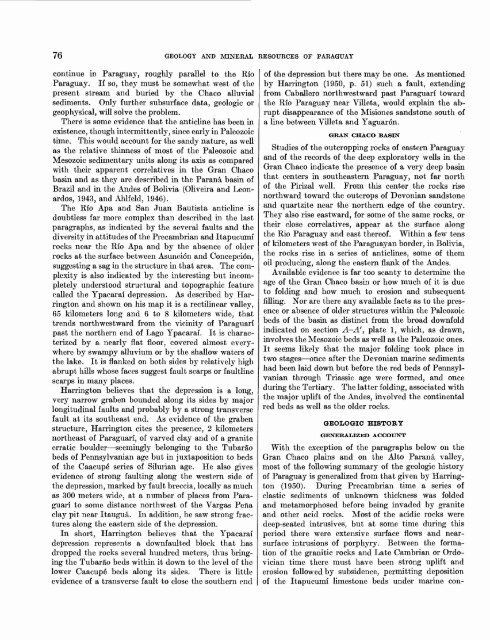Geology and Mineral Resources of Paraguay A Reconnaissance
Geology and Mineral Resources of Paraguay A Reconnaissance
Geology and Mineral Resources of Paraguay A Reconnaissance
- No tags were found...
You also want an ePaper? Increase the reach of your titles
YUMPU automatically turns print PDFs into web optimized ePapers that Google loves.
76 GEOLOGY AND MINERAL RESOURCES OF PARAGUAYcontinue in <strong>Paraguay</strong>, roughly parallel to the Rio<strong>Paraguay</strong>. If so, they must be somewhat west <strong>of</strong> thepresent stream <strong>and</strong> buried by the Chaco alluvialsediments. Only further subsurface data, geologic orgeophysical, will solve the problem.Ther£ is some evidence that the anticline has been inexistence, though intermittently, since early in Paleozoictime. This would account for the s<strong>and</strong>y nature, as wellas the relative thinness <strong>of</strong> most <strong>of</strong> the Paleozoic <strong>and</strong>Mesozoic sedimentary units along its axis as comparedwith their apparent correlatives in the Gran Chacobasin <strong>and</strong> as they are described in the Parana basin <strong>of</strong>Brazil <strong>and</strong> in the Andes <strong>of</strong> Bolivia (Oliveira <strong>and</strong> Leonardos,1943, <strong>and</strong> Ahlfeld, 1946).The Rio Apa <strong>and</strong> San Juan Bautista anticline isdoubtless far more complex than described in the lastparagraphs, as indicated by the several faults <strong>and</strong> thediversity in attitudes <strong>of</strong> the Precambrian <strong>and</strong> Itapucumirocks near the Rio Apa <strong>and</strong> by the absence <strong>of</strong> olderrocks at the surface between Asuncion <strong>and</strong> Concepcidn,suggesting a sag in the structure in that area. The complexityis also indicated by the interesting but incompletelyunderstood structural <strong>and</strong> topographic featurecalled the Ypacarai depression. As described by Harrington<strong>and</strong> shown on his map it is a rectilinear valley,65 kilometers long <strong>and</strong> 6 to 8 kilometers wide, thattrends northwestward from the vicinity <strong>of</strong> Paraguaripast the northern end <strong>of</strong> Lago Ypacarai. It is characterizedby a nearly flat floor, covered almost everywhereby swampy alluvium or by the shallow waters <strong>of</strong>the lake. It is flanked on both sides by relatively highabrupt hills whose faces suggest fault scarps or faultlinescarps in many places.Harrington believes that the depression is a long,very narrow graben bounded along its sides by majorlongitudinal faults <strong>and</strong> probably by a strong transversefault at its southeast end. As evidence <strong>of</strong> the grabenstructure, Harrington cites the presence, 2 kilometersnortheast <strong>of</strong> Paraguari, <strong>of</strong> varved clay <strong>and</strong> <strong>of</strong> a graniteerratic boulder seemingly belonging to the Tubaraobeds <strong>of</strong> Pennsylvanian age but in juxtaposition to beds<strong>of</strong> the Caacupe series <strong>of</strong> Silurian age. He also givesevidence <strong>of</strong> strong faulting along the western side <strong>of</strong>the depression, marked by fault breccia, locally as muchas 300 meters wide, at a number <strong>of</strong> places from Paraguarito some distance northwest <strong>of</strong> the Vargas Penaclay pit near Itaugua. In. addition, he saw strong fracturesalong the eastern side <strong>of</strong> the depression.In short, Harrington believes that the Ypacaraidepression represents a downfaulted block that hasdropped the rocks several hundred meters, thus bringingthe Tubarao beds within it down to the level <strong>of</strong> thelower Caacupe1 beds along its sides. There is littleevidence <strong>of</strong> a transverse fault to close the southern end<strong>of</strong> the depression but there may be one. As mentionedby Harrington (1950, p. 51) such a fault, extendingfrom Caballero northwestward past Paraguari towardthe Rio <strong>Paraguay</strong> near Villeta, would explain the abruptdisappearance <strong>of</strong> the Misiones s<strong>and</strong>stone south <strong>of</strong>a line between Villeta <strong>and</strong> Yaguaron.GRAN CHACO BASINStudies <strong>of</strong> the outcropping rocks <strong>of</strong> eastern <strong>Paraguay</strong><strong>and</strong> <strong>of</strong> the records <strong>of</strong> the deep exploratory wells in theGran Chaco indicate the presence <strong>of</strong> a very deep basinthat centers in southeastern <strong>Paraguay</strong>, not far north<strong>of</strong> the Pirizal well. From this center the rocks risenorthward toward the outcrops <strong>of</strong> Devonian s<strong>and</strong>stone<strong>and</strong> quartzite near the northern edge <strong>of</strong> the country.They also rise eastward, for some <strong>of</strong> the same rocks, orthen- close correlatives, appear at the surface alongthe Rio <strong>Paraguay</strong> <strong>and</strong> east there<strong>of</strong>. Within a few tens<strong>of</strong> kilometers west <strong>of</strong> the <strong>Paraguay</strong>an border, in Bolivia,the rocks rise in a series <strong>of</strong> anticlines, some <strong>of</strong> themoil producing, along the eastern flank <strong>of</strong> the Andes.Available evidence is far too scanty to determine theage <strong>of</strong> the Gran Chaco basin or how much <strong>of</strong> it is dueto folding <strong>and</strong> how much to erosion <strong>and</strong> subsequentfilling. Nor are there any available facts as to the presenceor absence <strong>of</strong> older structures within the Paleozoicbeds <strong>of</strong> the basin as distinct from the broad downfoldindicated on section A-A', plate 1, which, as drawn,involves the Mesozoic beds as well as the Paleozoic ones.It seems likely that the major folding took place intwo stages once after the Devonian marine sedimentshad been laid down but before the red beds <strong>of</strong> Pennsylvanianthrough Triassic age were formed, <strong>and</strong> onceduring the Tertiary. The latter folding, associated withthe major uplift <strong>of</strong> the Andes, involved the continentalred beds as well as the older rocks.GEOLOGIC HISTORYGENERALIZED ACCOUNTWith the exception <strong>of</strong> the paragraphs below on theGran Chaco plains <strong>and</strong> on the Alto Parana valley,most <strong>of</strong> the following summary <strong>of</strong> the geologic history<strong>of</strong> <strong>Paraguay</strong> is generalized from that given by Harrington (1950). During Precambrian time a series <strong>of</strong>clastic sediments <strong>of</strong> unknown thickness was folded<strong>and</strong> metamorphosed before being invaded by granite<strong>and</strong> other acid rocks. Most <strong>of</strong> the acidic rocks weredeep-seated intrusives, but at some time during thisperiod there were extensive surface flows <strong>and</strong> nearsurfaceintrusions <strong>of</strong> porphyry. Between the formation<strong>of</strong> the granitic rocks <strong>and</strong> Late Cambrian or Ordoviciantime there must have been strong uplift <strong>and</strong>erosion followed by subsidence, permitting deposition<strong>of</strong> the Itapucumi limestone beds under marine con-
















